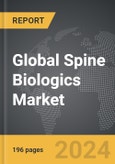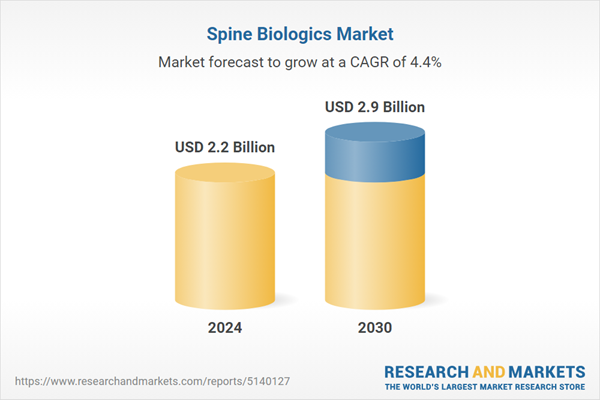The global market for Spine Biologics was valued at US$2.2 Billion in 2024 and is projected to reach US$2.9 Billion by 2030, growing at a CAGR of 4.4% from 2024 to 2030. This comprehensive report provides an in-depth analysis of market trends, drivers, and forecasts, helping you make informed business decisions. The report includes the most recent global tariff developments and how they impact the Spine Biologics market.
Segments: Product (Spinal Allografts, Bone Graft Substitutes, Cell-Based Matrix); End-Use (Hospitals, Ambulatory Surgery Centers (ASCs), Other End-Uses).
Geographic Regions/Countries: World; United States; Canada; Japan; China; Europe (France; Germany; Italy; United Kingdom; Spain; Russia; and Rest of Europe); Asia-Pacific (Australia; India; South Korea; and Rest of Asia-Pacific); Latin America (Argentina; Brazil; Mexico; and Rest of Latin America); Middle East (Iran; Israel; Saudi Arabia; United Arab Emirates; and Rest of Middle East); and Africa.
The analysts continuously track trade developments worldwide, drawing insights from leading global economists and over 200 industry and policy institutions, including think tanks, trade organizations, and national economic advisory bodies. This intelligence is integrated into forecasting models to provide timely, data-driven analysis of emerging risks and opportunities.
Global Spine Biologics Market - Key Trends and Drivers Summarized
Why Are Spine Biologics Transforming Spine Surgery and Recovery?
Spine biologics are transforming spine surgery and recovery by offering innovative solutions for bone regeneration, fusion enhancement, and tissue repair. These biologics, which include bone grafts, growth factors, stem cells, and synthetic biomaterials, are widely used in spinal fusion procedures, disc replacement, and spinal deformity correction. With the increasing prevalence of spinal disorders such as degenerative disc disease, scoliosis, and trauma-related injuries, the demand for biologics that improve fusion rates, reduce healing times, and minimize complications is growing rapidly. Spine biologics are particularly advantageous in minimally invasive spine surgery (MISS) and complex spinal reconstructions, providing better clinical outcomes and faster recovery for patients.How Are Technological Advancements Impacting the Spine Biologics Market?
Technological advancements in biomaterials, synthetic bone grafts, and cell-based therapies are significantly enhancing the effectiveness, safety, and application scope of spine biologics. The development of next-generation biologics, such as demineralized bone matrices (DBMs), recombinant human growth factors, and allograft bone products, is providing more effective options for spinal fusion and bone healing. Innovations in stem cell-based therapies, gene therapy, and regenerative medicine are gaining traction, offering new possibilities for tissue repair, nerve regeneration, and personalized spine care. Additionally, the emergence of combination biologics and hybrid solutions, which integrate multiple biologic agents and synthetic materials, is expanding the treatment options available for spine surgeons, supporting the growth of the spine biologics market.Which Market Segments Are Leading the Growth of the Spine Biologics Industry?
Product types include bone grafts, bone graft substitutes, platelet-rich plasma (PRP), bone morphogenetic proteins (BMPs), and cell-based matrices, with bone graft substitutes holding the largest market share due to their widespread use in spinal fusion procedures. Applications of spine biologics span spinal fusion, disc replacement, trauma repair, and deformity correction, with spinal fusion being the dominant segment due to the high demand for biologics that enhance fusion rates and promote bone healing. End-use sectors include hospitals, specialized clinics, and research institutes, with hospitals leading the market due to their advanced surgical capabilities and multidisciplinary care teams. Geographically, North America and Europe are the largest markets for spine biologics, driven by high adoption of regenerative medicine and advanced biologic products, while Asia-Pacific is expected to witness rapid growth due to rising healthcare investments and increasing prevalence of spinal disorders.What Are the Key Drivers of Growth in the Spine Biologics Market?
The growth in the spine biologics market is driven by several factors, including rising demand for biologics in minimally invasive spine surgery (MISS), technological advancements in biomaterials, synthetic bone grafts, and regenerative medicine, and the increasing focus on enhancing fusion rates, bone regeneration, and healing times. The need to provide effective, safe, and personalized biologics for a wide range of spinal conditions is driving the demand for spine biologics across various surgical and non-surgical settings. Technological innovations in next-generation biologics, stem cell-based therapies, gene therapy, and combination biologics, coupled with advancements in regenerative medicine, synthetic biomaterials, and personalized spine care, are enhancing the efficacy, safety, and marketability of spine biologics, supporting market growth. The expansion of biologic applications in trauma, degenerative disc disease, scoliosis treatment, and spinal deformity correction, along with the growing emphasis on evidence-based practice, clinical guidelines, and patient education, is creating new opportunities for market players. Additionally, the focus on developing cost-effective, scalable, and hybrid spine biologics for diverse patient populations is further propelling the growth of the spine biologics market.Report Scope
The report analyzes the Spine Biologics market, presented in terms of units. The analysis covers the key segments and geographic regions outlined below.Segments: Product (Spinal Allografts, Bone Graft Substitutes, Cell-Based Matrix); End-Use (Hospitals, Ambulatory Surgery Centers (ASCs), Other End-Uses).
Geographic Regions/Countries: World; United States; Canada; Japan; China; Europe (France; Germany; Italy; United Kingdom; Spain; Russia; and Rest of Europe); Asia-Pacific (Australia; India; South Korea; and Rest of Asia-Pacific); Latin America (Argentina; Brazil; Mexico; and Rest of Latin America); Middle East (Iran; Israel; Saudi Arabia; United Arab Emirates; and Rest of Middle East); and Africa.
Key Insights:
- Market Growth: Understand the significant growth trajectory of the Spinal Allografts segment, which is expected to reach US$1.4 Billion by 2030 with a CAGR of a 3.9%. The Bone Graft Substitutes segment is also set to grow at 5.0% CAGR over the analysis period.
- Regional Analysis: Gain insights into the U.S. market, valued at $593.2 Million in 2024, and China, forecasted to grow at an impressive 6.8% CAGR to reach $593.8 Million by 2030. Discover growth trends in other key regions, including Japan, Canada, Germany, and the Asia-Pacific.
Why You Should Buy This Report:
- Detailed Market Analysis: Access a thorough analysis of the Global Spine Biologics Market, covering all major geographic regions and market segments.
- Competitive Insights: Get an overview of the competitive landscape, including the market presence of major players across different geographies.
- Future Trends and Drivers: Understand the key trends and drivers shaping the future of the Global Spine Biologics Market.
- Actionable Insights: Benefit from actionable insights that can help you identify new revenue opportunities and make strategic business decisions.
Key Questions Answered:
- How is the Global Spine Biologics Market expected to evolve by 2030?
- What are the main drivers and restraints affecting the market?
- Which market segments will grow the most over the forecast period?
- How will market shares for different regions and segments change by 2030?
- Who are the leading players in the market, and what are their prospects?
Report Features:
- Comprehensive Market Data: Independent analysis of annual sales and market forecasts in US$ Million from 2024 to 2030.
- In-Depth Regional Analysis: Detailed insights into key markets, including the U.S., China, Japan, Canada, Europe, Asia-Pacific, Latin America, Middle East, and Africa.
- Company Profiles: Coverage of players such as AlloSource, Alphatec Spine, Inc., DePuy Synthes, Exactech, Inc., Globus Medical, Inc. and more.
- Complimentary Updates: Receive free report updates for one year to keep you informed of the latest market developments.
Some of the 46 companies featured in this Spine Biologics market report include:
- AlloSource
- Alphatec Spine, Inc.
- DePuy Synthes
- Exactech, Inc.
- Globus Medical, Inc.
- Harvest Technologies
- Medtronic, Inc.
- NuVasive, Inc.
Tariff Impact Analysis: Key Insights for 2025
Global tariff negotiations across 180+ countries are reshaping supply chains, costs, and competitiveness. This report reflects the latest developments as of April 2025 and incorporates forward-looking insights into the market outlook.The analysts continuously track trade developments worldwide, drawing insights from leading global economists and over 200 industry and policy institutions, including think tanks, trade organizations, and national economic advisory bodies. This intelligence is integrated into forecasting models to provide timely, data-driven analysis of emerging risks and opportunities.
What’s Included in This Edition:
- Tariff-adjusted market forecasts by region and segment
- Analysis of cost and supply chain implications by sourcing and trade exposure
- Strategic insights into geographic shifts
Buyers receive a free July 2025 update with:
- Finalized tariff impacts and new trade agreement effects
- Updated projections reflecting global sourcing and cost shifts
- Expanded country-specific coverage across the industry
Table of Contents
I. METHODOLOGYII. EXECUTIVE SUMMARY2. FOCUS ON SELECT PLAYERSIII. MARKET ANALYSISSOUTH KOREAREST OF ASIA-PACIFICARGENTINABRAZILMEXICOREST OF LATIN AMERICAIRANISRAELSAUDI ARABIAUNITED ARAB EMIRATESREST OF MIDDLE EASTIV. COMPETITION
1. MARKET OVERVIEW
3. MARKET TRENDS & DRIVERS
4. GLOBAL MARKET PERSPECTIVE
UNITED STATES
CANADA
JAPAN
CHINA
EUROPE
FRANCE
GERMANY
ITALY
UNITED KINGDOM
SPAIN
RUSSIA
REST OF EUROPE
ASIA-PACIFIC
AUSTRALIA
INDIA
LATIN AMERICA
MIDDLE EAST
AFRICA
Companies Mentioned (Partial List)
A selection of companies mentioned in this report includes, but is not limited to:
- AlloSource
- Alphatec Spine, Inc.
- DePuy Synthes
- Exactech, Inc.
- Globus Medical, Inc.
- Harvest Technologies
- Medtronic, Inc.
- NuVasive, Inc.
Table Information
| Report Attribute | Details |
|---|---|
| No. of Pages | 196 |
| Published | April 2025 |
| Forecast Period | 2024 - 2030 |
| Estimated Market Value ( USD | $ 2.2 Billion |
| Forecasted Market Value ( USD | $ 2.9 Billion |
| Compound Annual Growth Rate | 4.4% |
| Regions Covered | Global |









